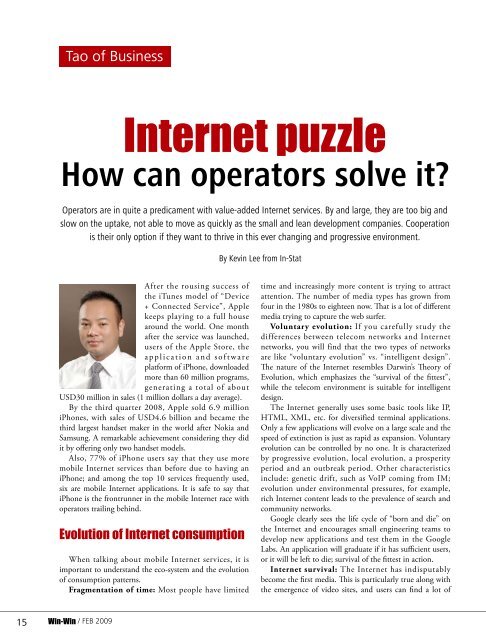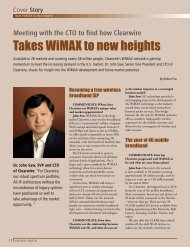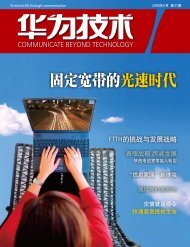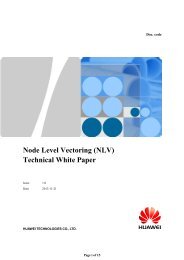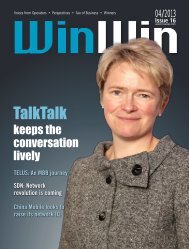EMOBILE: the mobile broadband revolutionist - Huawei
EMOBILE: the mobile broadband revolutionist - Huawei
EMOBILE: the mobile broadband revolutionist - Huawei
You also want an ePaper? Increase the reach of your titles
YUMPU automatically turns print PDFs into web optimized ePapers that Google loves.
Tao of Business<br />
Internet puzzle<br />
How can operators solve it?<br />
Operators are in quite a predicament with value-added Internet services. By and large, <strong>the</strong>y are too big and<br />
slow on <strong>the</strong> uptake, not able to move as quickly as <strong>the</strong> small and lean development companies. Cooperation<br />
is <strong>the</strong>ir only option if <strong>the</strong>y want to thrive in this ever changing and progressive environment.<br />
By Kevin Lee from In-Stat<br />
After <strong>the</strong> rousing success of<br />
<strong>the</strong> iTunes model of “Device<br />
+ Connected Service”, Apple<br />
keeps playing to a full house<br />
around <strong>the</strong> world. One month<br />
after <strong>the</strong> service was launched,<br />
users of <strong>the</strong> Apple Store, <strong>the</strong><br />
a p p l i c a t i o n a n d s o f t w a re<br />
platform of iPhone, downloaded<br />
more than 60 million programs,<br />
generating a total of about<br />
USD30 million in sales (1 million dollars a day average).<br />
By <strong>the</strong> third quarter 2008, Apple sold 6.9 million<br />
iPhones, with sales of USD4.6 billion and became <strong>the</strong><br />
third largest handset maker in <strong>the</strong> world after Nokia and<br />
Samsung. A remarkable achievement considering <strong>the</strong>y did<br />
it by offering only two handset models.<br />
Also, 77% of iPhone users say that <strong>the</strong>y use more<br />
<strong>mobile</strong> Internet services than before due to having an<br />
iPhone; and among <strong>the</strong> top 10 services frequently used,<br />
six are <strong>mobile</strong> Internet applications. It is safe to say that<br />
iPhone is <strong>the</strong> frontrunner in <strong>the</strong> <strong>mobile</strong> Internet race with<br />
operators trailing behind.<br />
Evolution of Internet consumption<br />
When talking about <strong>mobile</strong> Internet services, it is<br />
important to understand <strong>the</strong> eco-system and <strong>the</strong> evolution<br />
of consumption patterns.<br />
Fragmentation of time: Most people have limited<br />
time and increasingly more content is trying to attract<br />
attention. The number of media types has grown from<br />
four in <strong>the</strong> 1980s to eighteen now. That is a lot of different<br />
media trying to capture <strong>the</strong> web surfer.<br />
Voluntary evolution: If you carefully study <strong>the</strong><br />
differences between telecom networks and Internet<br />
networks, you will find that <strong>the</strong> two types of networks<br />
are like “voluntary evolution” vs. “intelligent design”.<br />
The nature of <strong>the</strong> Internet resembles Darwin’s Theory of<br />
Evolution, which emphasizes <strong>the</strong> “survival of <strong>the</strong> fittest”,<br />
while <strong>the</strong> telecom environment is suitable for intelligent<br />
design.<br />
The Internet generally uses some basic tools like IP,<br />
HTML, XML, etc. for diversified terminal applications.<br />
Only a few applications will evolve on a large scale and <strong>the</strong><br />
speed of extinction is just as rapid as expansion. Voluntary<br />
evolution can be controlled by no one. It is characterized<br />
by progressive evolution, local evolution, a prosperity<br />
period and an outbreak period. O<strong>the</strong>r characteristics<br />
include: genetic drift, such as VoIP coming from IM;<br />
evolution under environmental pressures, for example,<br />
rich Internet content leads to <strong>the</strong> prevalence of search and<br />
community networks.<br />
Google clearly sees <strong>the</strong> life cycle of “born and die” on<br />
<strong>the</strong> Internet and encourages small engineering teams to<br />
develop new applications and test <strong>the</strong>m in <strong>the</strong> Google<br />
Labs. An application will graduate if it has sufficient users,<br />
or it will be left to die; survival of <strong>the</strong> fittest in action.<br />
Internet survival: The Internet has indisputably<br />
become <strong>the</strong> first media. This is particularly true along with<br />
<strong>the</strong> emergence of video sites, and users can find a lot of<br />
15<br />
Win-Win / FEB 2009


